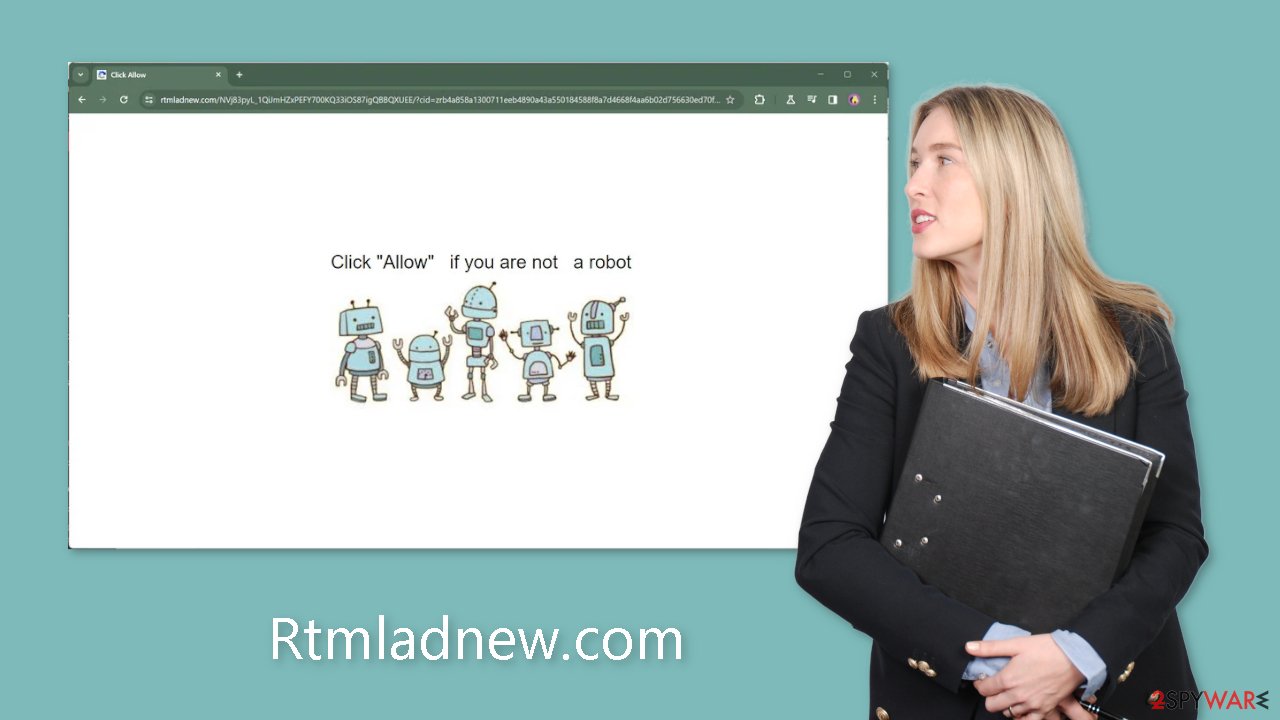Rtmladnew.com ads (fake) - Free Guide
Rtmladnew.com ads Removal Guide
What is Rtmladnew.com ads?
Rtmladnew.com is a bogus site set up by crooks to generate income using pop-ups

Rtmladnew.com is a phony website created by crooks with the goal of making money through pay-per-click advertisements. It uses deceptive social engineering techniques to trick users into signing up for push notifications. They are asked to click the “Allow” button on the website, seemingly to confirm that they are not robots.
This strategy frequently resembles a valid captcha verification process that websites use to protect against automated bots. This familiarity is used by crooks to trick unwary visitors. However, as soon as users select “Allow,” they are barraged with intrusive pop-up ads.
The website provides no more information besides the misleading message and graphics. Fraudsters may also make use of rogue ad networks that show advertisements for risky websites. As a result, users risk unintentionally arriving at malicious websites designed to trick them into providing personal information, downloading potentially unwanted programs (PUPs),[1] or even infecting their devices with malware.
Distribution methods
You might be wondering how Rtmladnew.com appeared on your screen. These pages frequently appear out of nowhere when you are browsing the internet. This occurrence is primarily due to their use of deceptive adverts and covert redirects to hide their existence within other shady websites.
We strongly advise staying away from websites that engage in illegal activity, like illegal streaming platforms. These websites are unregulated and frequently have fake “Download” and “Play” buttons that open new tabs with malicious advertisements on them. To have a safer online experience, it is best to stick to web pages that you are familiar with and trust.
| NAME | Rtmladnew.com |
| TYPE | Push notification spam; adware |
| SYMPTOMS | Pop-up ads start appearing in the corner of the screen after the “Allow” button is pressed |
| DISTRIBUTION | Shady websites, deceptive ads, redirects, freeware installations |
| DANGERS | Links embedded in the push notifications can lead to dangerous websites where users can be tricked into providing their personal information and suffer from monetary losses |
| ELIMINATION | Users can block push notifications via browser settings |
| FURTHER STEPS | It is recommended to use a repair tool like FortectIntego after the removal to fix any remaining damage |
Clear your browsers
It is advised to clear your browser after coming across spam websites. Different tracking technologies are used by websites to collect information about you, such as your IP address, geolocation, the websites you visit, the links you click, and your online purchases. The usage of cookies[2] is frequently used in this data collecting.
While trustworthy websites use cookies to deliver relevant content and improve user experience, others also use them to make money by selling user data to ad networks and other third parties. Fortunately, FortectIntego provides an automatic response to this problem. This dependable program is made to stop monitoring and delete existing data, protecting your online privacy.

Block notifications from Rtmladnew.com
Because push notifications are subscription-based, they can be turned on and off only manually. We have a detailed guide for the most popular browsers below:
Google Chrome (desktop):
- Open Google Chrome browser and go to Menu > Settings.
- Scroll down and click on Advanced.
- Locate the Privacy and security section and pick Site Settings > Notifications.
![Stop notifications on Chrome PC 1 Stop notifications on Chrome PC 1]()
- Look at the Allow section and look for a suspicious URL.
- Click the three vertical dots next to it and pick Block. This should remove unwanted notifications from Google Chrome.
![Stop notifications on Chrome PC 2 Stop notifications on Chrome PC 2]()
Google Chrome (Android):
- Open Google Chrome and tap on Settings (three vertical dots).
- Select Notifications.
- Scroll down to Sites section.
- Locate the unwanted URL and toggle the button to the left (Off setting).
![Stop notifications on Chrome Android Stop notifications on Chrome Android]()
Mozilla Firefox:
- Open Mozilla Firefox and go to Menu > Options.
- Click on Privacy & Security section.
- Under Permissions, you should be able to see Notifications. Click Settings button next to it.
![Stop notifications on Mozilla Firefox 1 Stop notifications on Mozilla Firefox 1]()
- In the Settings – Notification Permissions window, click on the drop-down menu by the URL in question.
- Select Block and then click on Save Changes. This should remove unwanted notifications from Mozilla Firefox.
![Stop notifications on Mozilla Firefox 2 Stop notifications on Mozilla Firefox 2]()
Safari:
- Click on Safari > Preferences…
- Go to Websites tab and, under General, select Notifications.
- Select the web address in question, click the drop-down menu and select Deny.
![Stop notifications on Safari Stop notifications on Safari]()
MS Edge:
- Open Microsoft Edge, and click the Settings and more button (three horizontal dots) at the top-right of the window.
- Select Settings and then go to Advanced.
- Under Website permissions, pick Manage permissions and select the URL in question.
- Toggle the switch to the left to turn notifications off on Microsoft Edge.
![Stop notifications on Edge 2 Stop notifications on Edge 2]()
MS Edge (Chromium):
- Open Microsoft Edge, and go to Settings.
- Select Site permissions.
- Go to Notifications on the right.
- Under Allow, you will find the unwanted entry.
- Click on More actions and select Block.
![Stop notifications on Edge Chromium Stop notifications on Edge Chromium]()
Check your PC for adware
PUPs can also be held responsible for undesirable browser behavior. Pages like Rtmladnew.com occasionally come up suddenly and without any user input. This incident can be linked to adware,[3] a category of PUPs capable of secretly introducing commercial content onto your computer. Many of these adware applications pose as “useful” utilities, making it difficult for regular users to recognize them.
This emphasizes how crucial it is to have specialized security tools like SpyHunter 5Combo Cleaner and Malwarebytes. The ability to check your computer and find questionable background activities is a feature of anti-malware programs. Additionally, by warning users when potentially dangerous files are attempting to enter the system, they can prevent such infections from occurring in the first place.
However, if you still want to do this yourself, you can follow our step-by-step instructions for Windows and Mac machines:
Windows 10/8:
- Enter Control Panel into Windows search box and hit Enter or click on the search result.
- Under Programs, select Uninstall a program.
![Uninstall from Windows 1 Uninstall from Windows 1]()
- From the list, find the entry of the suspicious program.
- Right-click on the application and select Uninstall.
- If User Account Control shows up, click Yes.
- Wait till uninstallation process is complete and click OK.
![Uninstall from Windows 2 Uninstall from Windows 2]()
Windows 7/XP:
- Click on Windows Start > Control Panel located on the right pane (if you are Windows XP user, click on Add/Remove Programs).
- In Control Panel, select Programs > Uninstall a program.
![Uninstall from Windows 7/XP Uninstall from Windows 7/XP]()
- Pick the unwanted application by clicking on it once.
- At the top, click Uninstall/Change.
- In the confirmation prompt, pick Yes.
- Click OK once the removal process is finished.
Mac:
- From the menu bar, select Go > Applications.
- In the Applications folder, look for all related entries.
- Click on the app and drag it to Trash (or right-click and pick Move to Trash)
![Uninstall from Mac 1 Uninstall from Mac 1]()
To fully remove an unwanted app, you need to access Application Support, LaunchAgents, and LaunchDaemons folders and delete relevant files:
- Select Go > Go to Folder.
- Enter /Library/Application Support and click Go or press Enter.
- In the Application Support folder, look for any dubious entries and then delete them.
- Now enter /Library/LaunchAgents and /Library/LaunchDaemons folders the same way and terminate all the related .plist files.
![Uninstall from Mac 2 Uninstall from Mac 2]()
How to prevent from getting adware
Stream videos without limitations, no matter where you are
There are multiple parties that could find out almost anything about you by checking your online activity. While this is highly unlikely, advertisers and tech companies are constantly tracking you online. The first step to privacy should be a secure browser that focuses on tracker reduction to a minimum.
Even if you employ a secure browser, you will not be able to access websites that are restricted due to local government laws or other reasons. In other words, you may not be able to stream Disney+ or US-based Netflix in some countries. To bypass these restrictions, you can employ a powerful Private Internet Access VPN, which provides dedicated servers for torrenting and streaming, not slowing you down in the process.
Data backups are important – recover your lost files
Ransomware is one of the biggest threats to personal data. Once it is executed on a machine, it launches a sophisticated encryption algorithm that locks all your files, although it does not destroy them. The most common misconception is that anti-malware software can return files to their previous states. This is not true, however, and data remains locked after the malicious payload is deleted.
While regular data backups are the only secure method to recover your files after a ransomware attack, tools such as Data Recovery Pro can also be effective and restore at least some of your lost data.
- ^ Potentially unwanted program. Wikipedia, the free encyclopedia.
- ^ Dusan Vasic. What Are Cookies? The Good and the Bad of Browser Cookies. Dataprot. Security Solutions.
- ^ Adware. Malwarebytes. Cybersecurity Basics.













